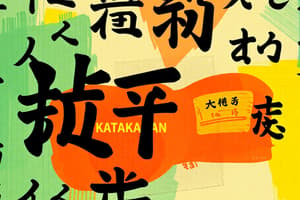Podcast
Questions and Answers
Grammar,
Grammar,
- analyzing
- describing
- linking (correct)
- comparing
Vocabulary
Vocabulary
- phrases (correct)
- grammar
- kanji
- learners
Kanji
Kanji
- grammar
- vocabulary (correct)
- phrases
- sentences
Japanese
Japanese
Grammar?
Grammar?
Kanji
Kanji
漢字は、約何世紀頃日本に採用されたのか?
漢字は、約何世紀頃日本に採用されたのか?
日本語の文法は、英語に比べてどのように知られているか?
日本語の文法は、英語に比べてどのように知られているか?
「だけ」は、どのようなニュアンスを表すのか?
「だけ」は、どのようなニュアンスを表すのか?
「つもり」は、どのような意味を表すのか?
「つもり」は、どのような意味を表すのか?
日本語の名前に使われる漢字のコレクションは、どこで見つかるのか?
日本語の名前に使われる漢字のコレクションは、どこで見つかるのか?
「だ」は、どのようなニュアンスを加えるのか?
「だ」は、どのようなニュアンスを加えるのか?
Flashcards are hidden until you start studying
Study Notes
Japanese: An Overview of Kanji, Grammar, and Vocabulary
Kanji
Kanji, or 漢字, are Chinese characters that were adopted in Japan as a writing system around the first century CE. These characters were simplified and adapted over time to better fit the phonetics of the Japanese language. While kanji can be complex and challenging for beginners, mastering them is crucial for reading and writing in Japanese.
Resources
- Kanshudo provides an introduction to the nature and origin of kanji, with a focus on the components and reading of the characters.
- Jinmeiyō collections offer a comprehensive collection of kanji used in modern Japanese names, as well as historical and obsolete characters.
Grammar
Japanese grammar is known for its simplicity compared to English. The language has a limited number of tenses, and no singular/plural distinction or articles. However, Japanese grammar can be complex, with a large number of particles and complex sentence structures.
Key Grammar Points
- た (ta) marks nouns and な-adjectives as present tense and positive, while だ (da) adds an emphatic nuance in certain contexts.
- だけ (dake) means "only" and indicates the limitation or extent of something.
- だった (datta) is a plain form past tense marker, typically used with nouns and な-adjectives.
- つもり (tsumori) expresses the speaker's predetermined intention.
- て form links actions, events, and states, with the relationship between linked words varying depending on the context.
Resources
- Tofugu offers a comprehensive index of Japanese grammar lessons, covering various topics and providing examples to help learners understand the concepts.
- JapanesePod101 provides a beginner's guide to basic Japanese grammar, explaining the differences between Japanese and English grammar and offering examples to help learners grasp key concepts.
Vocabulary
While Japanese vocabulary can be extensive, beginners can start by focusing on basic vocabulary and phrases. As proficiency grows, learners can gradually expand their vocabulary to include more complex words and phrases.
Resources
- JapanesePod101 suggests starting with a solid grasp of vocabulary and phrases before diving into kanji.
- Kanshudo offers a guide to studying kanji, including how to use Kanshudo to search for kanji effectively.
In summary, learning Japanese involves a combination of understanding kanji, mastering grammar, and expanding vocabulary. While kanji may initially seem daunting, it is a vital part of the language. Grammar provides the structure for sentences, and vocabulary allows learners to communicate effectively. By focusing on these three areas in a strategic and consistent manner, learners can make significant progress in their Japanese language journey.
Studying That Suits You
Use AI to generate personalized quizzes and flashcards to suit your learning preferences.




